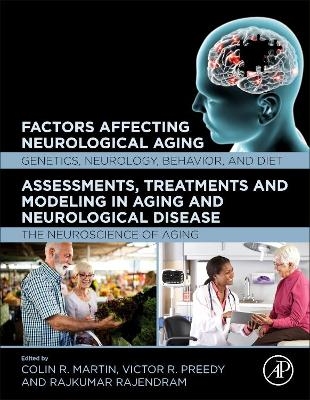
The Neuroscience of Aging
Academic Press Inc
978-0-12-818369-4 (ISBN)
Factors Affecting Neurological Aging: Genetics, Neurology, Behavior, and Diet is a comprehensive reference on the genetic and behavioral features associated with neurological aging and associated disorders. This book discusses the mechanisms underlying neurological aging and provides readers with a detailed introduction to the aging of neural connections and complexities in biological circuitries, as well as the physiological, behavioral, molecular, and cellular features of neurological aging. It also examines the use of animal modelling of aging and neurological disease.
Colin R. Martin RN, BSc, MSc, PhD, MBA, YCAP, FHEA, C.Psychol, AFBPsS, C.Sci is Professor of Clinical Psychobiology and Applied Psychoneuroimmunology and Clinical Director of the Institute of Health and Wellbeing at the University of Suffolk, UK. He is a Chartered Health Psychologist and a Chartered Scientist. He also trained in analytical biochemistry, this aspect reflecting the psychobiological focus of much of his research within mental health. He has published or has in press well over 300 research papers and book chapters. He is a keen book author and editor having written and/or edited more than 50 books. These outputs include the prophetic insight into the treatment of neurological disease, Handbook of Behavior, Food and Nutrition (2011), Nanomedicine and the Nervous System (2012), Oxidative Stress and Dietary Antioxidants in Neurological Disease (2020), Zika Virus Impact, Diagnosis, Control and Models (2021), Factors Affecting Neurodevelopment: Genetics, Neurology, Behavior and Diet (2021), Diagnosis and Treatment of Spinal Cord Injury (2022), The Neurobiology, Physiology, and Psychology of Pain (2022) and The Handbook of Lifespan Cognitive Behavioral Therapy: Childhood, Adolescence, Pregnancy, Adulthood, and Aging (2023). Professor Martin is particularly interested in all aspects of the relationship between underlying physiological substrates and behavior, particularly in how these relationships manifest in both acute and chronic psychiatric disorder. He has published original research germane to significant mental health disorders including the areas of schizophrenia, anxiety, depression, self-esteem, alcohol and drug dependency, high secure forensic mental health and personality disorder. He has a keen interest in the impact of postviral illness and is actively involved in clinical research post-Covid pandemic and in particular, the impact of Long Covid on psychological, neurological, physiological and social functioning. He is involved in collaborative International research with many European and Non-European countries. Victor R. Preedy BSc, PhD, DSc, FRSB, FRSPH, FRSC, FRCPath graduated with an Honours Degree in Biology and Physiology with Pharmacology. After gaining his University of London PhD, he received his Membership of the Royal College of Pathologists. He was later awarded his second doctorate (DSc), for his contribution to protein metabolism in health and disease. He is Professor of Clinical Biochemistry (Hon) at King’s College Hospital and Emeritus Professor of Nutritional Biochemistry at King’s College London. He has Honorary Professorships at the University of Hull, and the University of Suffolk. Professor Preedy was the Founding Director and then long-term Director of the Genomics Centre at King’s College London from 2006 to 2020. Professor Preedy has been awarded fellowships of the Royal Society of Biology, the Royal College of Pathologists, the Royal Society for the Promotion of Health, the Royal Institute of Public Health, the Royal Society for Public Health, the Royal Society of Chemistry and the Royal Society of Medicine. He carried out research when attached to the National Heart Hospital (part of Imperial College London), The School of Pharmacy (now part of University College London) and the MRC Centre at Northwick Park Hospital. He has collaborated with international research groups in Finland, Japan, Australia, USA, and Germany. To his credit, Professor Preedy has published over 750 articles, which includes peer-reviewed manuscripts based on original research, abstracts and symposium presentations, reviews and edited books. Dr Rajkumar Rajendram is a clinician scientist with a focus on internal medicine, anaesthesia, intensive care and peri-operative medicine. He graduated with distinctions from Guy’s, King’s and St. Thomas Medical School, King’s College London in 2001. As an undergraduate he was awarded several prizes, merits and distinctions in pre-clinical and clinical subjects. Dr Rajendram began his post-graduate medical training in general medicine and intensive care in Oxford. He attained membership of the Royal College of Physicians (MRCP) in 2004 and completed specialist training in acute and general medicine in Oxford in 2010. Dr Rajendram subsequently practiced as a Consultant in Acute General Medicine at the John Radcliffe Hospital, Oxford. Dr Rajendram also trained in anaesthesia and intensive care in London and was awarded a fellowship of the Royal College of Anaesthetists (FRCA) in 2009. He completed advanced training in regional anaesthesia and intensive care. He was awarded a fellowship of the Faculty of Intensive Care Medicine (FFICM) in 2013 and obtained the European diploma of intensive care medicine (EDIC) in 2014. He then moved to the Royal Free London Hospitals as a Consultant in Intensive Care, Anaesthesia and Peri-operative Medicine. He has been a fellow of the Royal College of Physicians of Edinburgh (FRCP Edin) and the Royal College of Physicians of London (FRCP Lond) since 2017 and 2019 respectively. He is currently a Consultant in Internal Medicine at King Abdulaziz Medical City, National Guard Heath Affairs, Riyadh, Saudi Arabia. Dr Rajendram’s focus on improving outcomes from Coronavirus Disease 2019 (COVID-19) has involved research on point of care ultrasound and phenotypes of COVID-19. Dr Rajendram also recognises that nutritional support is a fundamental aspect of medical care. This is particularly important for patients with COVID-19. As a clinician scientist he has therefore devoted significant time and effort into nutritional science research and education. He is an affiliated member of the Nutritional Sciences Research Division of King’s College London and has published over 400 textbook chapters, review articles, peer-reviewed papers and abstracts.
Assessments, Treatments and Modeling in Aging and Neurological Disease: The Neuroscience of Aging
I. Introductory chapters: Setting the scene for the neuroscience of aging 1. The concept of productive aging; 2. Quality of life in the over 80s; 3. Successful aging and diet; 4. The impact of positive social relations on the quality of life of older people. An alternative to medicalization from an integral perspective; 5. The brain in life span: use of phase fMagnetic Resonance Imaging (MRI); 6. Neuronal structure in aging: Cytoskeleton in health and disease; 7. Sporadic Alzheimer’s Triad: Age, Sex, and ApoE; 8. How polymorphisms impact: BDNF polymorphism, inhibitory performance and the elderly; 9. Menopause as an aging process and alcohol misuse; 10. Brain banking and aging
II. Impairments and Diseases11. Dementia or no dementia in the very elderly. Why?; 12. Neuropsychology, Social Cognition and Loss of Insight in Frontotemporal Dementia; 13. Neuroinflammation in the elderly; 14. Cortical microinfarcts and the aging brain; 15. Vascular brain injury and neurodegeneration in elderly racial and ethnic minority populations; 16. Hearing loss amongst the elderly; 17. Aging Auditory Cortex: The Impact of Reduced Inhibition on Function; 18. Aging and vestibular disorders; 19. Brain aging in HIV and antiretrovirals; 20. Antioxidants, Methylmercury, and Aging; 21. Aging and the effects of ethanol on the brain: Comparing the effects of different aging
III. Biomarkers And Diagnosis 22. Aging brain: Radiological biomarkers; 23. Plasma ADAM10 as a biomarker of mental impairment in the elderly; 24. Circulating microRNAs as biomarkers of healthy elderly; 25. DHEA as a biomarker of aging in humans and nonhuman primates: Synthesis, neuroprotection and cognitive function; 26. Evaluation of subjective memory abilities in elderly people; 27. The Functional Activities Questionnaire: Applications to aging; 28. Autobiographical memory as a diagnostic tool in aging; 29. Assessment tools for subjective memory abilities in elderly people; 30. Knowledge of Memory Aging
IV. Management and Treatments 31. Pharmacological use of transient receptor potential (TRP) ion channel antagonists in neurological disease: effects on swallowing and implications for nutrition; 32. Aripiprazole: features and use in the aged; 33. Cognition-Enhancing Drugs and Applications to Aging; 34. Creatine supplementation and impact on the aging brain; 35. Photobiomodulation as a brain-boosting strategy in aging; 36. Innovation in deep brain stimulation in aging: a focus on Parkinson Disease; 37. Exergames: what they are and how they can be used to improve cognition in aging; 38. Linking cognitive decline and ballroom dance as a therapeutic intervention in the elderly; 39. Active experiencing training in the elderly; 40. Psychiatric self-management, smartphone apps and older adults; 41. Psychosocial Interventions for Suicide Prevention in the Elderly: Advances and Future Directions
V. Models And Modelling42. D-galactose-induced aging and brain mitochondria; 43. Drosophila as a model organism in ageing research; 44. The Zebrafish (Danio rerio) and its uses for understanding the neuroscience of aging: applications and observation; 45. Murine models of primary Tauopathy as a model of aging; 46. Modelling nutrition and brain aging in rodents; 47. Modelling primates and neurological aging: a focus on Alzheimer's disease; 48. Linking aging and animal models to neurodegeneration: the Striatum, Substantia Nigra and Parkinson's Disease; 49. Behavioral evaluation of aging
VI. Resources50. Research and recommended resources in the neuroscience of agingFactors Affecting Neurological Aging: Genetics, Neurology, Behavior, And Diet
I. Genetics, Molecular and Cellular Biology1. Genetics of frontotemporal dementia; 2. Aging, brain-derived neurotrophic factor (BDNF) and its polymorphism; 3. Aging, demented patients, and polymorphisms in cytokine genes; 4. RNA fragments and brain aging; 5. Centrosome functions and remodeling during neuronal development and centrosome abnormalities in neuronal disorders, disease, and in aging; 6. Brain aging and microarray analysis; 7. Human nuclear tau and aging; 8. Lipoxidation: features, neurological tissues and aging; 9. Aging and brain amino acids; 10. How 3’,5’-cyclic nucleotide phosphodiesterases change in the brain with normal aging and dementia; 11. The prohibitin complex in aging and neurodegeneration; 12. Synaptic ATPase and energy metabolism in the nervous system: roles and changes in the aging process
II. Neurological and Imaging Features13. Microstructural Imaging of the Human Brain with Normal and "Abnormal" Aging using Diffusion Magnetic Resonance Imaging; 14. Imaging the brain and its vascular in aging: applications of optical coherence tomography angiography; 15. Potential involvement of perineuronal nets in brain aging: an anatomical point of view; 16. Grey-matter networks in aging; 17. Brain synapse-related proteins what they do and how they change in aging; 18. Macro- and chaperone-mediated autophagy in aging; 19. Neuronal L-type calcium channels in aging; 20. D-serine-regulated glutamatergic transmission and microglia: impact of aging; 21. Voltage-gated potassium channels and the aging brain; 22. Dendritic spine remodeling and aging; 23. High-density lipoprotein-cholesterol and neuroaging: memory, gyrification of the insular and frontal opercular cortex; 24. Astrocyte and microglial aging: morphology and modelling; 25. Neural scaffolding: features, profiles and the aging cerebellum; 26. BACE1 RNAi, memory and aging; 27. Aging, myelination and the optic nerve; 28. Linking proteostasis, brain aging, and ischemia; 29. Luteinizing hormone and the aging nervous system; 30. Insights into aging using transcranial magnetic stimulation; 31. Alpha rhythms: What they are and how they alter with aging; 32. Nicotine and its derivatives in healthy brain aging
III. Physiological Aspects 33. Environmental enrichment and physiological aging; 34. Treadmill exercise and neuroinflammation: links with aging; 35. Impact of aerobic exercise on brain structure in models of aging: hippocampus and beyond; 36. The physiology of fitness and the brain in aging; 37. Aging, Babble Noise and the processing of speech perception; 38. The blood-brain barrier in aging
IV. Behavior And Psychopathological Aspects 39. Linking aging, anticholinergic drug use, and cognitive impairment; 40. Cognitive Frailty: Definition, components and impact on disability, and mortality; 41. The physiology of the "Brain-muscle loop" in aging; 42. Disentangling the effects of aging and ovarian hormone loss on sleep: Implications for health and disease; 43. Role of DNA methylation in aging-related cognitive functioning'; 44. Depression in the elderly and psychobiotics
V. Diet And Nutrition45. Aging, dietary patterns and cognition; 46. Geriatric nutritional risk index: Application, and limitations; 47. Diet, inflammatory biomarkers, and brain aging; 48. DASH diet and brain aging; 49. The ketogenic diet and healthy brain aging; 50. Autophagy and aging: diet, exercise, and the link with the target of rapamycin complex 1 (TORC); 51. Dietary Flavonoids and Brain Health in Ageing: food for Thought; 52. Antioxidant effects of curcumin and neuroaging; 53. Lipoic acid and vitamin D3 and their use in preventing brain aging; 54. Aging and working memory: Impact of the leucine metabolite beta hydroxy-beta-methyl butyrate; 55. Hydration, the brain and aging
| Erscheint lt. Verlag | 25.6.2021 |
|---|---|
| Verlagsort | San Diego |
| Sprache | englisch |
| Maße | 216 x 276 mm |
| Gewicht | 3900 g |
| Themenwelt | Geisteswissenschaften ► Psychologie ► Entwicklungspsychologie |
| Naturwissenschaften ► Biologie ► Humanbiologie | |
| Naturwissenschaften ► Biologie ► Zoologie | |
| ISBN-10 | 0-12-818369-1 / 0128183691 |
| ISBN-13 | 978-0-12-818369-4 / 9780128183694 |
| Zustand | Neuware |
| Informationen gemäß Produktsicherheitsverordnung (GPSR) | |
| Haben Sie eine Frage zum Produkt? |
aus dem Bereich


